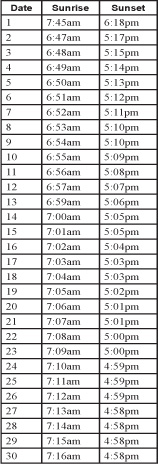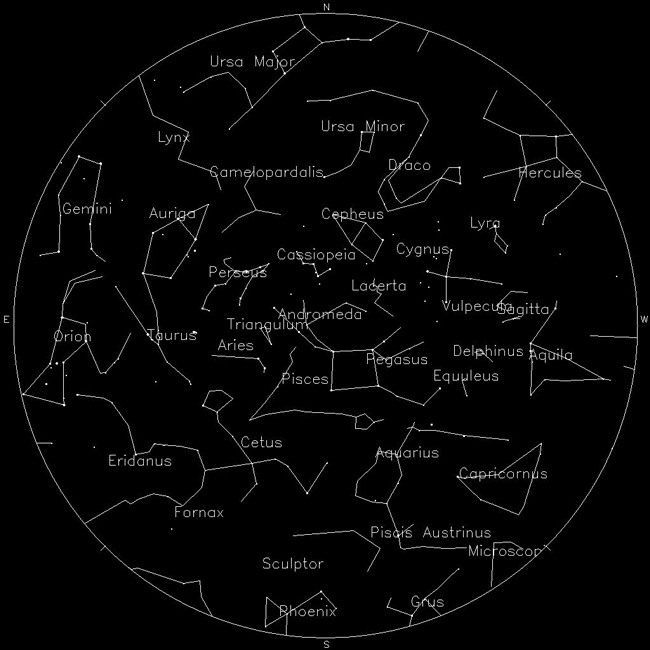Sunrise
and Sunset Times for
November 2008 |
 |
LOCAL STAR COUNT
WabiSabi invites you to enjoy the night sky and participate in an international star count to raise awareness of light pollution. Join me at Ken’s Lake at 7:00pm on Saturday, November 1, to learn to identify the constellations in the night sky and to conduct a local star survey for the Great Worldwide Star Count. If skies are cloudy or weather inclement, we will reschedule the event for Sunday, November 2, at the same time. Bring the star chart from this page and a flashlight covered with a red shield or a small brown paper bag. Dress warmly and bring a blanket or chair if desired. Meet at the parking lot beside the lake. This is a free event for all ages. Call 259-9114 or 259-4743 to RSVP or for more information.
DAY LENGTH
Daylight savings time ends at 2:00am on Sunday, November 2. Notice that the time of sunset changes very little by the end of November. The combined effects of the sun’s low declination to the south and the slight increase in the earth’s speed as it approaches perigee (closest point to the sun) result in little change in the time of sunset. Sunrises are not affected until mid-December. Civil twilight provides adequate light for about one-half hour after sunset. Nautical twilight continues another half hour as color and detail fade from the landscape. Skies darken and the brightest stars appear. Astronomical twilight begins about one and one-half hours after sunset as the last trace of sunlight disappears from the sky .
MOON HAPPENINGS
November begins with a waxing crescent moon in the southwestern sky at the beginning of evening twilight. Since the moon rises about 45-60 minutes later each day, it will appear higher in the sky each evening. By November 20 the moon is most visible in morning twilight, rising after midnight and setting before the next evening. As twilight fades on November 1 a thin crescent moon sets alongside Venus to the southwest about 10 degrees above a flat horizon. On November 3 the moon appears just below Jupiter. On November 5 the moon reaches first quarter phase. The full moon rises at 4:27pm on November 12, reaching peak fullness at 11:18pm. On November 13 the moon rises in the northeastern sky with the Pleiades. The third quarter moon appears high in the sky in the early morning twilight of November 19. Bright objects near the moon on the morning of November 20 are Regulus (magnitude +1 star) and Saturn (to the east). On November 24 the moon rises below Saturn, as twilight breaks, with Spica (magnitude 0 star) above it. The new moon occurs at 9:56am on November 27. On November 30 look low on the southwestern horizon just after sunset for a faint crescent moon just below Jupiter and Venus.
GREAT WORLDWIDE STAR COUNT
Join this international effort, as a citizen scientist, to count the number of stars that can be seen from different localities around the world. Participants in the Northern Hemisphere will estimate the number of stars visible around the constellation Cygnus, the Swan. Observations can be made anytime from October 20 through November 3. Locate Cygnus on this month’s star chart then look for it overhead between 8:30pm and 9:00pm. The GWWSC website provides easy-to-use magnitude charts for estimating the number of stars you see. Determine latitude and longitude for your observation site with a GPS unit, the Geocoder link on the GWWSC website, or a topo map. The star count is sponsored by the University Corporation for Atmospheric Research in Boulder, Colorado, to raise awareness of the effect of light pollution on the night sky. Go to their website at http://www.starcount.org/ for directions and a reporting form.
MAGNITUDE OF THE STARS
Magnitude measures the brightness of stars. Absolute magnitude measures actual differences in size and intensity of a star’s light as if all stars were the same distance from Earth. Apparent magnitude, more useful to stargazers, ranks a star’s brightness based on what we actually see. A small nearby star appears brighter than a larger more distant star. The current magnitude scale ranges from -26.8 (brightness of the sun) to +27 (faintest objects seen with largest telescopes). Stars with negative magnitudes are brighter than stars with positive magnitudes. Magnitude 1 stars are 2.5 times brighter than magnitude 2 stars; magnitude 2 stars 2.5 times brighter than magnitude 3 stars; etc. A magnitude 1 star is 100 times brighter than a magnitude 6 star, the faintest level that can be easily viewed without magnification. Well-marked constellations, like the Big Dipper, Cassiopeia, and Orion, are defined by 1st and 2nd magnitude stars. Fainter constellations, like Pisces and Cancer, contain only 3rd or 4th magnitude stars. Some of the brighter stars like Rigel, Capella, and Vega are designated magnitude 0. Sirius, the brightest of all stars, is -1.6; Venus ranges from -3.9 to -4.7.
METEOR EVENTS
The Taurid Meteor Showers are worth watching because they often produce spectacular fireballs. Fireballs are meteors brighter than magnitude -4 (brighter than Venus!). Look for these meteors during the first two weeks of November to the north and south of Taurus as it rises overhead towards midnight. Viewing conditions are optimal November 5-12 around midnight after the waxing crescent moon sets. The Leonid Meteor Shower appears November 13-20. Unfortunately, it competes with a full moon on November 13 and a waning moon that rises before midnight during the meteor peak on November 17/18.
Note: Hold your hand at arm’s length to measure apparent distances in the sky. Adjust for the size of your hand. The width of the little finger approximates 1.5 degrees. Middle, ring, and little finger touching represent about 5 degrees. The width of a fist is about 10 degrees. The hand stretched from thumb to little finger equals 20 degrees. The diameter of both the full moon and the sun spans only 0.5 degree.
VISIBLE PLANETS
Jupiter - Watch Jupiter descend lower in the southwestern sky each evening. Shining at magnitude -2, it moves closer to Venus until month’s end when the two planets approach within two degrees of one another.
Saturn - The early morning sky features Saturn, shining at magnitude +1. It appears higher in the sky each morning.
Venus - Shining at magnitude -4, Venus appears higher in the southwestern sky each evening. Venus has phases just like the moon since its orbit takes it between the earth and the sun. Currently, half its face towards earth is lit (like a quarter moon). On November 30 look for Venus just below Jupiter with a faint crescent moon beneath.
Note: Apparent magnitude values range from -4 to +6 for most planets and visible stars. The lower the value the brighter the object. A decrease of 1.0 magnitude is 2.5 times brighter.
Primary Sources: USGS, U.S. Naval Observatory,
http://www.fourmilab.ch/yoursky/
MAJOR
CONSTELLATIONS this MONTH |
Overhead
Andromeda
Aries
Pegasus
Pisces
Triangulum
|
Northward
Cassiopeia
Cepheus
Perseus
Ursa Major
Ursa Minor
|
Eastward
Auriga
Gemini
Orion
Taurus
|
Southward
Aquarius
Capricornus
Cetus
|
Westward
Aquila
Cygnus
Hercules
Lyra |
As twilight fades, Scorpius rests on the southwestern
horizon with the Summer Triangle overhead
and the Great Square of Pegasus to its
east. Perseus, Andromeda, and Pisces
line the eastern horizon.

Hold the star chart high above
your head and match the compass directions to the direction
you are facing.
Adjust the star chart by orienting Ursa Major (Big Dipper) to match its position
in the sky.
The star chart approximates the
night sky from astronomical twilight to midnight. As the night
and the month progress, the constellations will shift toward
the northwest. |
|